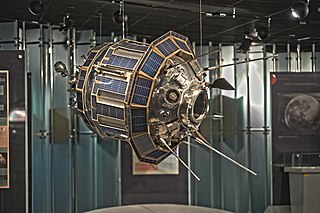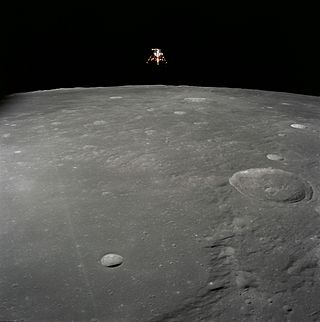
Luna 2, originally named the Second Soviet Cosmic Rocket and nicknamed Lunik 2 in contemporaneous media, was the sixth of the Soviet Union's Luna programme spacecraft launched to the Moon, E-1 No.7. It was the first spacecraft to reach the surface of the Moon, and the first human-made object to make contact with another celestial body.

Luna 3, or E-2A No.1, was a Soviet spacecraft launched in 1959 as part of the Luna programme. It was the first mission to photograph the far side of the Moon and the third Soviet space probe to be sent to the neighborhood of the Moon. The historic, never-before-seen views of the far side of the Moon caused excitement and interest when they were published around the world, and a tentative Atlas of the Far Side of the Moon was created from the pictures.
Luna E-6 No.2, also identified as No.1, and sometimes known in the West as Sputnik 25, was a Soviet spacecraft which launched in 1963, but was placed into a useless orbit due to a problem with the upper stage of the rocket that launched it. It was a 1,500-kilogram (3,300 lb) Luna Ye-6 spacecraft, the first of twelve to be launched. It was intended to be the first spacecraft to perform a soft landing on the Moon, a goal which would eventually be accomplished by the final Ye-6 spacecraft, Luna 9.

The Luna programme, occasionally called Lunik by western media, was a series of robotic spacecraft missions sent to the Moon by the Soviet Union between 1959 and 1976. The programme accomplished many firsts in space exploration, including first flyby of the Moon, first impact of the Moon and first photos of the far side of the Moon. Each mission was designed as either an orbiter or lander. They also performed many experiments, studying the Moon's chemical composition, gravity, temperature, and radiation.
Luna 5, or E-6 No.10, was an uncrewed Soviet spacecraft intended to land on the Moon as part of the Luna programme. It was intended to become the first spacecraft to achieve a soft landing on the Moon, however its retrorockets failed, and the spacecraft impacted the lunar surface.

Luna 9 (Луна-9), internal designation Ye-6 No.13, was an uncrewed space mission of the Soviet Union's Luna programme. On 3 February 1966, the Luna 9 spacecraft became the first spacecraft to achieve a survivable landing on a celestial body and return imagery from its surface.

Luna 15 was a robotic space mission of the Soviet Luna programme, that was in lunar orbit together with the Apollo 11 Command module Columbia.

Luna 18, part of the Ye-8-5 series, was an uncrewed space mission of the Luna program.
Luna 19, was an uncrewed space mission of the Luna program. Luna 19 extended the systematic study of lunar gravitational fields and location of mascons. It also studied the lunar radiation environment, the gamma-active lunar surface, and the solar wind. Photographic coverage via a television system was also obtained.

Luna 21 was an uncrewed space mission, and its spacecraft, of the Luna program, also called Lunik 21, in 1973. The spacecraft landed on the Moon and deployed the second Soviet lunar rover, Lunokhod 2. The primary objectives of the mission were to collect images of the lunar surface, examine ambient light levels to determine the feasibility of astronomical observations from the Moon, perform laser ranging experiments from Earth, observe solar X-rays, measure local magnetic fields, and study mechanical properties of the lunar surface material.
Luna 22 was an uncrewed space mission, part of the Soviet Luna program, also called Lunik 22.

Luna 23 was an uncrewed space mission of the Luna program developed by the Soviet Union.

Surveyor 2 was to be the second lunar lander in the uncrewed American Surveyor program to explore the Moon. After launch on September 20, 1966 a mid-course correction failure resulted in the spacecraft losing control. Contact was lost with the spacecraft at 9:35 UTC, September 22.

A Moon landing or lunar landing is the arrival of a spacecraft on the surface of the Moon, including both crewed and robotic missions. The first human-made object to touch the Moon was Luna 2 in 1959.

Luna E-1 No.2, sometimes identified by NASA as Luna 1958B, was a Soviet spacecraft which was lost in a launch failure in 1958. It was a 361-kilogram (796 lb) Luna E-1 spacecraft, the second of four to be launched. It was intended to impact the surface of the Moon, and in doing so become the first man-made object to reach its surface.

The physical exploration of the Moon began when Luna 2, a space probe launched by the Soviet Union, made a deliberate impact on the surface of the Moon on September 14, 1959. Prior to that the only available means of exploration had been observation from Earth. The invention of the optical telescope brought about the first leap in the quality of lunar observations. Galileo Galilei is generally credited as the first person to use a telescope for astronomical purposes; having made his own telescope in 1609, the mountains and craters on the lunar surface were among his first observations using it.
Luna E-8-5 No.402, also known as Luna Ye-8-5 No.402, and sometimes identified by NASA as Luna 1969C, was a Soviet spacecraft under Luna programme which was lost in a launch failure in 1969. It was a 5,600-kilogram (12,300 lb) Luna E-8-5 spacecraft, the first of at least eleven to be launched. It was intended to perform a soft landing on the Moon, collect a sample of lunar soil, and return it to the Earth. It was, along with Luna 15, one of two unsuccessful missions which had been launched by the Soviet Union in a last-ditch attempt to upstage the Apollo 11 landing under Moon race.

The Lunar Atmosphere and Dust Environment Explorer was a NASA lunar exploration and technology demonstration mission. It was launched on a Minotaur V rocket from the Mid-Atlantic Regional Spaceport on September 7, 2013. During its seven-month mission, LADEE orbited the Moon's equator, using its instruments to study the lunar exosphere and dust in the Moon's vicinity. Instruments included a dust detector, neutral mass spectrometer, and ultraviolet-visible spectrometer, as well as a technology demonstration consisting of a laser communications terminal. The mission ended on April 18, 2014, when the spacecraft's controllers intentionally crashed LADEE into the far side of the Moon, which, later, was determined to be near the eastern rim of Sundman V crater.

Chang'e 4 is a robotic spacecraft mission in the Chinese Lunar Exploration Program of the CNSA. China achieved humanity's first soft landing on the far side of the Moon with its touchdown on 3 January 2019.

Luna 25 was a failed Russian lunar lander mission by Roscosmos in August 2023 that planned to land near the lunar south pole, in the vicinity of the crater Boguslawsky.














